Saturday, February 26, 2005
The official NASA site has an article on their site on Titan's methane. The article mostly compares and contrasts methane on Titan with water on earth, and how the similarities and differences would effect such phenomena as rainbows, water bugs, boats, and waves. Still an interesting read, but nothing really newsworthy.
Raw Images of the Day
Some cool raw images have been posted in today. Here are a few of the best:
- Titan's Sub-Saturnian H. While this clear filter image shows mostly atmospheric features, but some surface features, like the prominent "H", can be discerned.
- Large Crater on Hyperion. The image shows a large impact crater on Hyperion, ~100 km across [note: haven't quite measured this yet]. Could this be Bond-Lassell Dorsa? If a crater, would a 100 km wide crater on a world the size of Hyperion have a central peak?
- Saturn as viewed from Titan. Obviously this image was taken from Cassini, not from Titan. But this image does give an idea of what Saturn would look like from Titan's surface. Saturn would only be viewable from Titan within methane windows in the spectrum. Secondly, unlike all those idealic images of Saturn from Titan showing the majestic rings, Saturn's rings would be edge-on and would not be seen but for a narrow line.
Friday, February 25, 2005
Next Enceladus Flyby Movie
Bjorn Jonsson, who works a lot with digital 3D animations and renderings of planetary bodies, has posted an animation showing the geometry of the next Enceladus flyby in 10 days. Just click on Cassini Stuff and go to the bottom of the page. The Cassini Stuff page on his site also has a great map of Enceladus that includes images taken last week.
Thursday, February 24, 2005
Titan CHARM Presentation
The JPL Cassini website has a new presentation posted as part of their series "Cassini-Huygens Analysis and Results from the Mission" on Titan. The presentation, given by Jonathan Lunine, covers major aspects of Titan science from the first few flybys of the satellite as well as the Huygens landing. The audio file that usually is associated with each presentation has not been posted yet. As soon as it is, I will be sure to update all of you on it. Nothing really ground breaking within the presentation, but it does give a good overview of where we are now after the T3 flyby.
Science Magazine - February 25, 2005
Tomorrow's issue of the journal Science is now online so those with a subscription can read those articles and those that don't can read the abstracts. Mostly this special issue is related to Saturn and data from SOI, but the imaging team has a paper focused on Phoebe and Iapetus (including results from the New Year's Eve flyby). Here are some tidbits from that paper:
- Phoebe has a mean radius of 106.6 ± 1 km and a density of 1.630 ± .045 g/cm3
- Layering on Phoebe suggests an oversaturation of impact events as more recent impacts excavate older impact ejecta
- Iapetus has three large impact basins within Cassini Regio, each with at least suggested central rises.
- Crater counts performed within the southern portion of the trailing hemisphere confirm the old age of Iapetus' surface as suggested by Voyager.
- Impact features within the equatorial ridge suggest that it is not the youngest feature on the surface. The lack of bright crater floors within Cassini Regio suggests that the leading hemisphere darkening is a fairly young feature.
- With regards to the bright/dark albedo asymmetry, Bright southern crater rims, dark northern crater rims, and dark north-trending streams in the bright-dark transition region suggest "long-distance, ballistic" transport of the dark material. This could be due to exogenic or endogenic causes, but the authors tend toward exogenic since a reasonable heat source needed for endogenic venting could not be found.
Other Science-related ISS images today
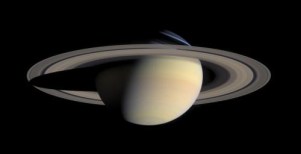
While not completely outer satellite related, CICLOPS has released other images related to this week's Science Cassini Special Issue. The best of the bunch is this view of Saturn, a mosaic consisting 42 frames (each consisting of three merged color images) showing the majesty that is Saturn. Other images released include a color view of the Dragon cloud, a storm system seen in the southern hemisphere of Saturn in mid-September of last year, as well as a series of images highlighting newly discovered ring features and evidence for an unseen moon in the Keeler Gap of the outer A ring.
Later today, we should see releases from other teams but I wouldn't count on it. When the papers show up on the Science magazine website, you can be sure that I will post the important satellite-related news here.
VLT Observations of Titan
The European Southern Observatory in Chile has released some new images and spectra taken of Titan during the Huygens landing by the Very Large Telescope's adaptive optics NAOS/CONICA instrument. The images produces are some of the clearest views of Titan taken from Earth. They clearly show prominent features in the anti-Saturn hemisphere, like the bright dark boundary on the western side of Xanadu, the landing site region, and the "Eye of the Dragon". Their best images come from the 1.6 micron methane window (as opposed to the 2.0 micron window that the Keck group uses). The results presented today do bode well for performing regional spectroscopy on Titan in conjunction with VIMS on Cassini (which has a higher spatial resolution but a lower spectral resolution) though their lack of temporal resolution compared to the Keck group will make their results a bit weaker I think for tracking changes in Titan's atmosphere.
Results from last year were reported on the prior incarnation of this blog.
Phoebe Feature Names
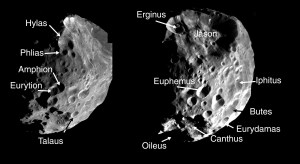
As part of a set of images related to the Science Cassini Special Issue, CICLOPS has released a pair of images showing a series of images of Phoebe taken last June. The images show feature names selected for various craters on the satellite. The names derive from the the Greek story of Jason and the Argonauts. The largest crater is Jason, named after the title character, or me, which ever you prefer.
Today's News
For those who are reading this now (~noon Thursday Mountain Standard Time), you should know that some major news will be posted here within the next few hours so don't forget to check back here later today.
Enceladus: Astronomy Picture of the Day
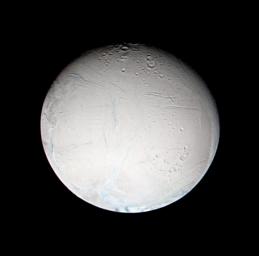
This Enceladus image released last week is the Astronomy Picture of the Day.
Telesto: Companion of Tethys
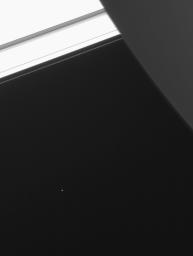
CICLOPS has released a new low-resolution view of Telesto, the leading trojan of Tethys. The Saturnian system is unique for having sets of co-orbital satellites. Janus and Epimetheus swap orbits every few years. Other satellites revolve around the L4 and L5 Lagrange points of Dione and Tethys. Helene and Polydeuces are leading and trailing trojans of Dione, respectively. Telesto and Calypso are leading and trailing trojans of Tethys, respectively. The resolution on Telesto in this image is 7 km/pixel.
Wednesday, February 23, 2005
New Titan Image: Zoomed in on Xanadu
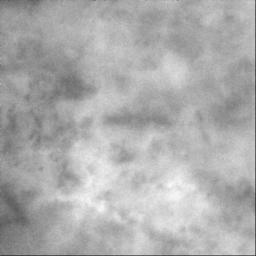
CICLOPS has released a newly processed frame showing a portion of western Xanadu. The pixel scale is 680 meters, but atmospheric scattering reduces the resolution to 5 times that value. A variety of albedo marking are seen in this image. What they are is still open to interpretation. The E-W short linear feature, for example, could be a volcanic fissure or tectonic. The lower portion of the image is part of a bright region in southwestern Xanadu that is the brightest area on Titan.
Higher resolution views of this area were released in December from Ta and Tb.
Saturnian Satellite Mutual Events from Cassini
tedstryk and Gsnorgathon posted a message on the MER forum regarding satellite mutual events as seen from Cassini. Mutual events are occurances where one satellite gets between another satellite and the sun or between another satellite an the observer. The former case is impossible in the current orbital position, but now that Cassini is much closer to the Saturn's equatorial plane, the latter case is. The post, linked above, mentions one such mutual event with Tethys and Dione and is best seen animated, as Gsnorgathon describes.
Update: Turns out that the moon in the background is not Tethys, but is instead Rhea. Also, MizarKey at the forum thread linked in this post's title has created an animated gif showing the mutual event.
Update2: Thanks to the Solar System Simulator for confirming the background moon as Rhea (compare with the Cassini view).
Update: Turns out that the moon in the background is not Tethys, but is instead Rhea. Also, MizarKey at the forum thread linked in this post's title has created an animated gif showing the mutual event.
Update2: Thanks to the Solar System Simulator for confirming the background moon as Rhea (compare with the Cassini view).
Astrobiology Magazine: Titan Rising
The Astrobiology Magazine has a two-part story on the events of the Huygens landing from the perspective of Michael Benson, a science reporter at Huygens mission control during the landing last month. A very interesting read and I urge all of you to check it out.
Titan Rising: Part I
Titan Rising: Part II
Titan Rising: Part I
Titan Rising: Part II
New Mimas Image: Target Locked
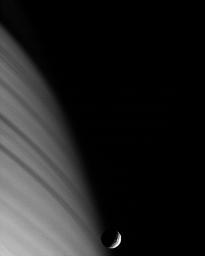
CICLOPS has released a new view of Mimas demonstrating the stability of the spacecraft pointing. The image shows Mimas against the backdrop of a ring-shadowed Saturn. For the observation, the spacecraft tracked Mimas during the exposure, leaving Mimas unsmeared while Saturn is smeared. The image was taken last month and the resolution on Mimas is 7 km/pixel.
Tuesday, February 22, 2005
New Tethys Image: Slice of Tethys
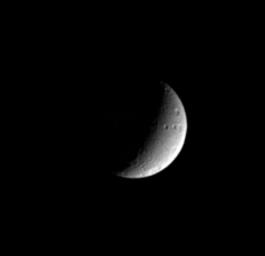
CICLOPS has released a new image of Tethys taken last month that shows three prominent craters along the eastern limb of Tethys: Phemius, Polyphemus, and Ajax. A better view of these craters was taken in October. That image shows these craters running from top to bottom in the middle of the disk.
Titan24

Gsnorgathon over at the MER Forum posted a message regarding a new program that shows a solar plot on Titan, as well as showing local panoramas (that show where the sun, Earth, and Saurn are in the sky at a particular point on Titan), as well as local time of a particular point on Titan. The program is quite customizable, allowing the user to add their own maps and add new locations to its database of Titan landmarks as features are named. Definitely a useful program.
Monday, February 21, 2005
Ganesa Macula

Finally, something other than Xanadu has been provisional named on Titan by the IAU. The pancake dome (or is it a crater...) seen by RADAR SAR back in October has been named Ganesa Macula, after the Hindu god of good fortune and wisdom. Ganesa Macula is located at 50N, 87W and is 160 km wide.
Last week's Flybys
So much news last week that one front page can not cover it all :-O So if you are here looking for the latest news from last week's encounter, check out the archive page for last week, linked in the title of this post and as always, on the right column of every page on this blog. So don't forget to check out the archives for past news.
Huygens detects geological activity on Titan (through 12C/13C ratio)
The New Scientist has an article online regarding new insights from the GCMS instrument onboard the Huygens probe which landed on Titan last month. After examining the isotropic ratio of Carbon-12 and Carbon-13, the GCMS team surmises that the carbon in Titan's atmosphere (in the form of methane) is replenished since the ratio does not show signs of fractionation. Fractionation is the process by which lighter isotopes are preferentially lost from an atmosphere compared to heavier isotopes. In the case of Titan, Nitrogen and Oxygen show fractionation (in the case of nitrogen, severe fractionation) but carbon does not. So in this case, methane is replenished at a rate greater than or equal to the loss rate, while oxygen and nitrogen are not. An interesting result that does have implications for the current state of Titan.
Thanks to imran for the heads up.
Thanks to imran for the heads up.
Planetary Society: Cassini's RADAR Images of Titan: Saturn's Moon is Beginning to Make Some Sense
The Planetary Society has an article online by Emily Lakdawalla on the latest view of Titan by the RADAR instrument on Cassini. The article definitely goes beyond the captions so far posted for these images and describes some of the speculation regarding the features seen thus far. In particular, the mysterious "cat scratches", which could be anything from dune fields to parallel grooves.

